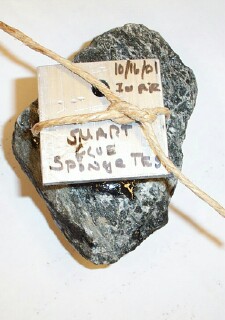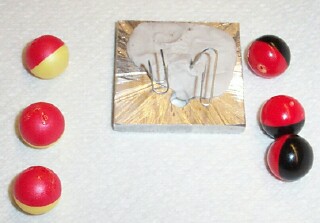|
Report
#7: building prototypes


Shown
above is a prototype applicator which delivers epoxy part
A and part B in two saturated sponges. The sponges are compressed
and rotated to mix and apply the epoxy.

Shown
above is a prototype applicator made of plastic spheres (paintball
cases) loaded with epoxy part A and part B with a syringe.
The plastic spheres are punctured with the paperclips, mounted
on a metal platform. The epoxy is mixed by twisting the platform
in situ.
report prepared by MMA engineers:
1/C Foley
3/C Sunde
________________________________________________________________
PSI-326 can be mixed (resin and hardener) underwater, as well
as applied underwater. Reports follow.
________________________________________________________________
This past Tuesday, my technician and I tried to test (whether) the
adhesive (PSI-326) would mix under water. Using a sponge (paint)
brush with the sponge ripped off, we were able to successfully mix
and apply the adhesive on a submerged rock. (Editor's note:
there is a plastic spatula under the sponge brush.) We
did three tests-- successfully adhering a nail to three differant
rocks. Once this was accomplished, we then tried adhering the
spatula itself to the rock. It would adhere, but because the handle
was made of wood, it would lift right off. We then fashioned some
aluminum spatulas, but due to human error, I believe, these would
not stick.
On 10/16 we experimented with building an adhesive/marker applicator
for Alvin underwater (use). In the previous labs we determined that
"Smart Glue" was the best choice for underwater use in this lab. We
met today's goals by finding out if the epoxy will mix underwater.
We put a half teasspoon of resin on a rock and added a half teaspoon
of hardener and then stirred them.
We (embedded) a plastic tab, a piece of glass and a nail in the epoxy.
They all hardened (set up), but the nail worked the best.
I worked with the sponge applicators and found that the foam type
paintbrush worked very well when applying such items as the nail and
plastic tabs to (our) Buzzards Bay rock collection. What also worked
extremely well for me and my technicians was the brillo type scrub pad,
using two separate cut out pieces of the pad. We added hardener to one
piece and resin to the the other piece and then applied it
simultaneously to a rock underwater from Buzzards Bay. We found
(we) must soak the pads well for the best results.
What (produced) the worst results, but wasn't a complete failure, was
the mesh sponge. It was too porous and the size was too large.
In the next lab I plan to experiment and cut up mesh sponges into
smaller sizes because as they are now they require more "SMART GLUE"
than we have available. Maybe (I will) use elastic (bands) or some
other type of fastener to keep a tight hold on the sponge so it will
stay together better during the compression of the sponge to the rock
and (during) the twisting motions.
The ambient seawater temperature for this lab was fourteen degrees
Celsius.
|

